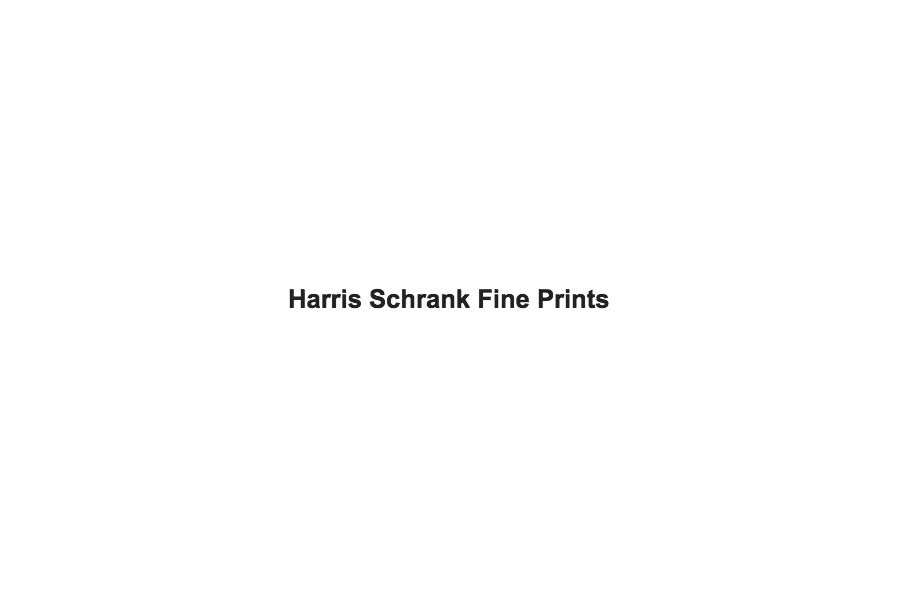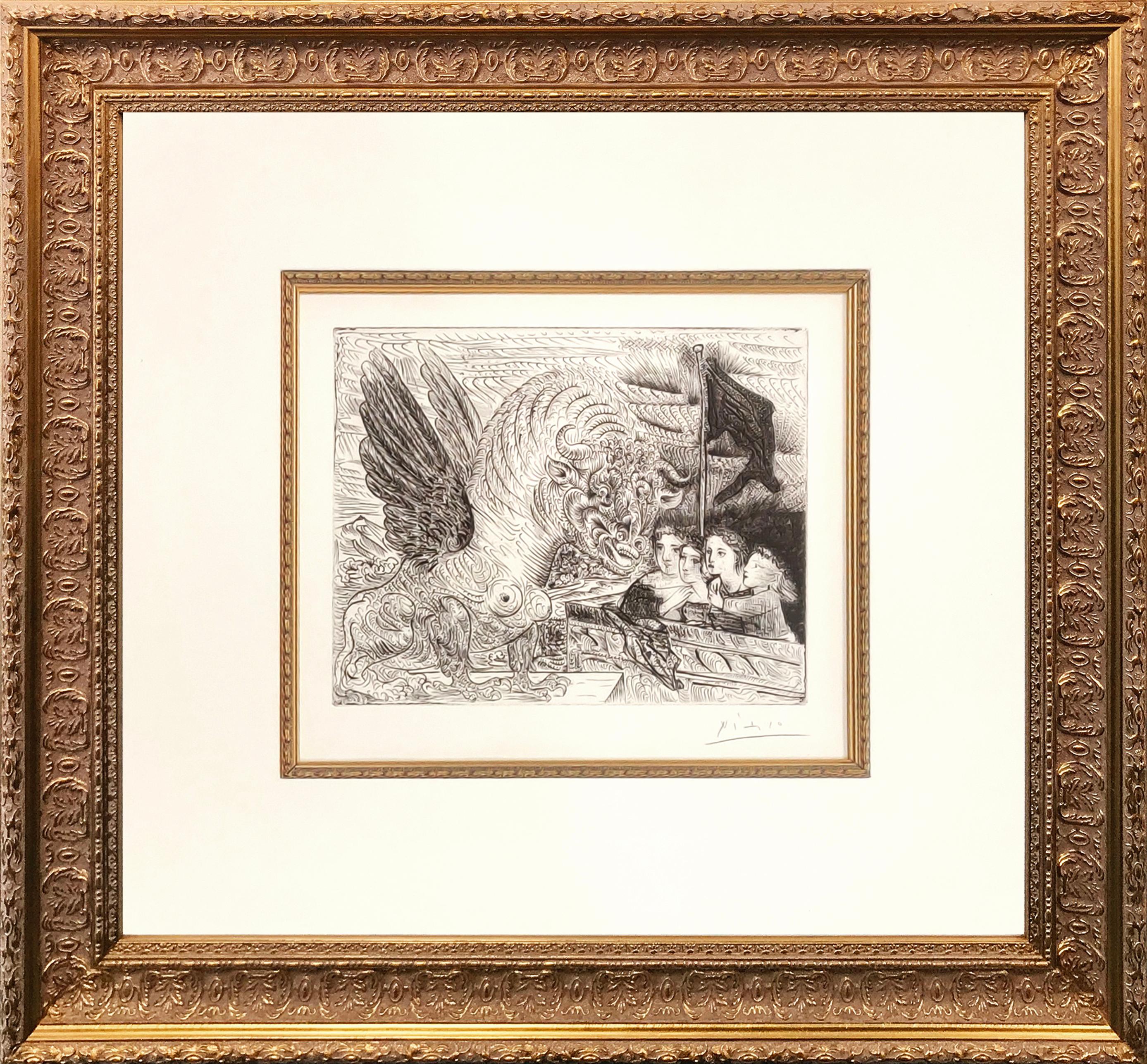Items Similar to La Fille aux Oies
Want more images or videos?
Request additional images or videos from the seller
1 of 2
Jean-Emile LaboureurLa Fille aux Oies1916
1916
About the Item
Jean-Emile Laboureur (1877-1943), La Fille aux Oies, engraving, 1916, signed in pencil lower left, numbered (4/40) lower right and inscribed “imp,” also titled lower left margin edge. Reference: Sylvan Laboureur 159, second state (of 2), from the edition of 40.In very good condition, with margins (remains of prior hinging verso), 6 3/4 x 6 1/8, the sheet 11 x 8 3/4 inches.
A fine impression of this early cubist-influenced engraving.
In 1917 Apollinaire wrote to Laboureur: “Je voudrais bien avoir le portrait de femme [L. 170] et la gardienne d’oies promis.”
- Creator:Jean-Emile Laboureur (1877-1943, French)
- Creation Year:1916
- Medium:
- Movement & Style:
- Period:
- Condition:
- Gallery Location:New York, NY
- Reference Number:1stDibs: LU51531783803

About the Seller
4.9
Recognized Seller
These prestigious sellers are industry leaders and represent the highest echelon for item quality and design.
Established in 2000
1stDibs seller since 2016
99 sales on 1stDibs
Typical response time: 3 hours
Associations
International Fine Print Dealers Association
- ShippingRetrieving quote...Ships From: New York, NY
- Return PolicyA return for this item may be initiated within 7 days of delivery.
More From This SellerView All
- Minne Playing with a Cat (Minne Jouant avec un Chat)By Jacques VillonLocated in New York, NYJacques Villon (1875-1963) etching, aquatint, and drypoint, Minne Playing with a Cat (Minne Jouant avec un Chat),1907, signed in pencil and numbered (12/30)(Ginestet and Pouillon 192...Category
Early 1900s Impressionist Figurative Prints
MaterialsDrypoint, Etching, Aquatint
- Goat Herder's WifeBy George BiddleLocated in New York, NYGeorge Biddle (1885-1973), Goat Herder’s Wife, 1928, lithograph, signed in pencil lower right and titled and numbered (64/100) in pencil lower left margin [with the inscription ”Bidd...Category
1920s Realist Animal Prints
MaterialsLithograph
- Le Souper des DockersBy Jean-Emile LaboureurLocated in New York, NYJean-Emile Laboureur (1877-1943), Le Souper des Dockers, engraving, 1919-1920, signed in pencil lower left, titled lower left, and numbered (27/35) lower right. Reference: Laboureur ...Category
1910s Cubist Figurative Prints
MaterialsEngraving
- Le Diner a L’AubergeBy Jean-Emile LaboureurLocated in New York, NYJean-Emile Laboureur (1877-1943), Le Diner a L’Auberge, 1917-1922), engraving, signed in pencil lower left and numbered (45/55) lower right. Reference: Sylvain Laboureur 173, second ...Category
1910s Cubist Figurative Prints
MaterialsEngraving
- Baptism (or, Group of Ten Men – One Seated)By Arthur B. DaviesLocated in New York, NYArthur B. Davies (1862-1928), Baptism (or, Group of Ten Men – One Seated), drypoint on zinc, 1917, signed in pencil , printed in black on very thin laid paper. In very good condition...Category
1910s Cubist Figurative Prints
MaterialsDrypoint
- Le Tir ForainBy Jean-Emile LaboureurLocated in New York, NYJean-Emile Laboureur (1877-1943), Le Tir Forain, engraving, 1920-21, signed in pencil lower left, titled lower left, and numbered 11//85 lower right, also annotated “imp.” [also with...Category
1920s Cubist Figurative Prints
MaterialsEngraving
You May Also Like
- TAUREAU AILE CONTEMPLE PAR QUATRE ENFANTS (BLOCH 229)By Pablo PicassoLocated in Aventura, FLPlate 13 from La Suite Vollard. Bloch 229. Baer 444. Etching on Montval paper. Signed in pencil, from the edition of 260 (there was also an edition of 50 with larger margins). Printe...Category
1930s Cubist Animal Prints
MaterialsPaper, Engraving
- MAMELOUK ENLEVANT UNE FEMME, ATTAQUE PAR UN MOUSQUETAIRE (BLOCH 1586)By Pablo PicassoLocated in Aventura, FLAquatint on wove paper. Hand signed and numbered by Pablo Picasso. Plate 106, from the serie "347 gravures" (B. 1586; BA. 1602 II B b 1). Published by Galerie Louise Leiris, Paris. ...Category
1960s Cubist Animal Prints
MaterialsPaper, Engraving
- PEINTRE AU TRAVAIL (BLOCH 1157)By Pablo PicassoLocated in Aventura, FLEtching, aquatint, drypoint and scraper, on Rives BFK paper. Hand signed and numbered by Pablo Picasso. Published by Galerie Louise Leiris, Paris. Image size 12.125 x 18.125 inches. ...Category
1930s Cubist Animal Prints
MaterialsDrypoint, Paper, Aquatint, Engraving
- After Georges Braque - Antiborée - LithographLocated in Collonge Bellerive, Geneve, CHLithograph after Georges Braque. Signed in the plate Edition of 150 Dimensions: 76 x 117 cm Bibliography: « Les Métamorphoses de Braque» of Heger de Loewenfeld and Raphaël de Cuttoli , Editions FAC, Paris, 1989. In 1961 Georges Braque decided with his laidary friend Heger de Loewenfeld to pick up certain of his works to in order to create artworks, this beautiful litograph is one of them. Héméra in the Mythology: In Greek mythology Hemera was the personification of day and one of the Greek primordial deities. She is the goddess of the daytime and, according to Hesiod, the daughter of Erebus and Nyx (the goddess of night). Hemera is remarked upon in Cicero's De Natura Deorum, where it is logically determined that Dies (Hemera) must be a god, if Uranus is a god. The poet Bacchylides states that Nyx and Chronos are the parents, but Hyginus in his preface to the Fabulae mentions Chaos as the mother/father and Nyx as her sister. She was the female counterpart of her brother and consort, Aether (Light), but neither of them figured actively in myth or cult. Hyginus lists their children as Uranus, Gaia, and Thalassa (the primordial sea goddess), while Hesiod only lists Thalassa as their child. The father of Cubism Three Cubist that distinguishes art historian periods were initiated and developed by Georges Braque: The Cubist Cézanne (1907-1909), Executive (1909-1912) and synthetic (1912-1922). Post-Impressionist and fawn, Braque no longer adheres to the contingency of a decorative way or the other. Cézanne’s paintings exhibited at the Grand Palais during the retrospective of 1907 are a revelation: Cézanne sought and invented a pictorial language. In his footsteps, Braque went to the South with the reasons of the Master. He returned with Estaque landscapes and surprising Ciotat it keeps Cezanne geometric model and retains the “passages” continuity from one surface to another to create the sensation of “turning around” of the object represented. But he wants to go after the consequences of the vision of Cezanne. In his paintings Houses in L’Estaque (1908) it simplifies the volumes of houses, neglects detail by removing doors and windows: the plastic rhythm that builds the table. Large Nude , a masterpiece of the period, can be considered the first work of Cézanne cubism . Systematizing and deepening Braque discoveries open the door analytical cubism. In 1909, his painting became more cerebral than sensual. The pattern is recreated in the two-dimensionality of the canvas, leaving aside any illusionistic perspective. In Still Life with Violin, objects are analyzed facets according to their characteristic elements, each facet referring to a particular view of the object. There are so many facets of points selected view: Table reflects the knowledge of the object and the ubiquity of the eye. Moreover, Braque is looking for the essence of the objects in the world rather than their contingency, which explains the absence of light source and use of muted colors (gray, ocher), contingent aspects of the object . But formal logic has stepped facets, erased any anecdote to the object and ultimately led to his painting a hermetic more marked on the edge of abstraction (see the series of Castle Roche-Guyon ). Braque, anxious to keep the concrete and refusing at all costs that the logic of Cubism takes the paintings to abstract, reintroduced signs of reality in his paintings in 1912 marks the beginning of Synthetic Cubism. Historians speak of “signs of real” rather than reality because what interests Braque, this is not to put reality into a table, but to create a painting which, by its language, refers to the real. To do this, he invented two major techniques XX th century inclusions and contributions. The inclusions consist of painting objects that have no real depth, materials (wallpaper in Nature morte aux playing cards faux wood is a pictorial inclusion) or letters (calligraphic inclusion in Portuguese ), made first brush and a few months later stencil. Contributions are defined in contrast with the collage on canvas of foreign materials: glued or sand paper, sawdust, etc.. Regarding the collages, Braque used for the first time in September 1912 a piece of adhesive paper imitating faux wood Compote...Category
1950s Cubist Animal Prints
MaterialsLithograph
- Le Singe - Etching by Pablo Picasso - 1940sBy Pablo PicassoLocated in Roma, ITNot Signed. Not Numbered. Edition of 225 pieces. Etching - aquatint. Belongs to the Suite "Histoire Naturelle de Buffon". Catalogue Bloch n.339. Passepartout included.Category
1940s Cubist Figurative Prints
MaterialsEtching, Paper
- MINOTAURE AVEUGLE CONDUIT PAR UNE PETITE FILLEBy (after) Pablo PicassoLocated in Aventura, FLSelected from the personal collection inherited by Marina Picasso, Pablo Picasso's granddaughter. After Pablo Picasso's death, his granddaughter Marina authorized the printing of t...Category
1980s Cubist Animal Prints
MaterialsLithograph, Paper
Recently Viewed
View AllMore Ways To Browse
Antique Imp
Antique Je
De La Fille
Jean Emile Laboureur
Modernist Heart
Pablo Picasso Signed Etching
1940s Original Lithograph
Picasso Pablo Posters
Maitres De
Theater Posters
Vintage La Rose
Antique Vellum
Contemporary Japanese Plates
New York Metropolitan Opera
Siena Painting
Signed Picasso 50
1900 Paintings From Germany
Roy Lichtenstein Original




